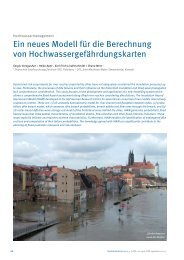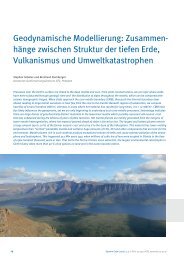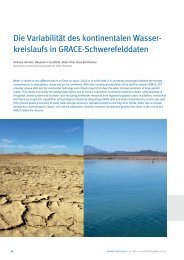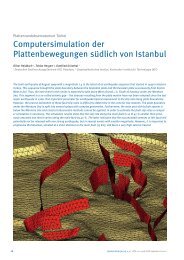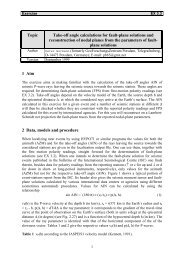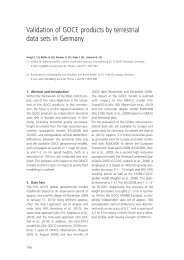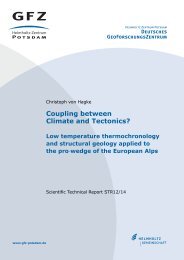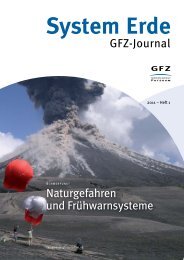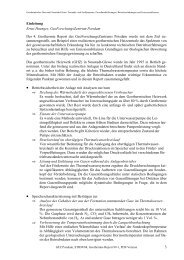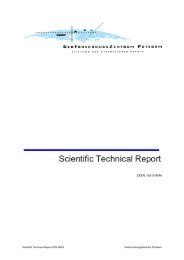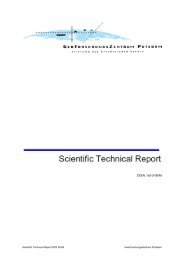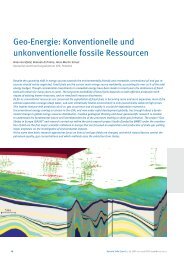2 Seismic Wave Propagation and Earth models
2 Seismic Wave Propagation and Earth models
2 Seismic Wave Propagation and Earth models
You also want an ePaper? Increase the reach of your titles
YUMPU automatically turns print PDFs into web optimized ePapers that Google loves.
2. <strong>Seismic</strong> <strong>Wave</strong> <strong>Propagation</strong> <strong>and</strong> <strong>Earth</strong> <strong>models</strong><br />
Eqs. (2.7) <strong>and</strong> (2.8) are solutions of the wave equation for the propagation of two independent<br />
types of seismic body waves, namely longitudinal (compressional - dilatational) P waves <strong>and</strong><br />
transverse (shear) S waves. Their velocities are<br />
<strong>and</strong><br />
vp =<br />
λ + 2μ<br />
=<br />
ρ<br />
6<br />
κ + 4μ<br />
/ 3<br />
ρ<br />
(2.9)<br />
μ<br />
vs = . (2.10)<br />
ρ<br />
Accordingly, for a Poisson solid with λ = μ vp/vs = 3 . This comes close to the vp/vs ratio of<br />
consolidated sedimentary <strong>and</strong> igneous rocks in the <strong>Earth</strong>’s crust (see Tab. 2.1). Eqs. (2.9) <strong>and</strong><br />
2.10) also mean that P (primary) waves travel significantly faster than S (secondary) waves<br />
<strong>and</strong> thus arrive ahead of S in a seismic record (see Fig. 2.3). The Poisson’s ratio is often used<br />
as a measure of the vp/vs ratio, namely<br />
σ = (vp 2 /vs 2 – 2)/2(vp 2 /vs 2 – 1) (2.11)<br />
Fig. 2.3 The three components of ground-velocity proportional digital records of the P <strong>and</strong> S<br />
waves from a local event, an aftershock of the Killari-Latur earthquake, India (18.10.1993), at<br />
a hypocentral distance of about 5.3 km.<br />
Note the simple transient waveform (wavelet) of P in the Z-component of Fig. 2.3. The<br />
waveform <strong>and</strong> duration of the primary body wave is related to the shape <strong>and</strong> duration of the<br />
source-time function. It is for an earthquake shear rupture usually a more or less complex<br />
displacement step (see Figs. 2.4 <strong>and</strong> 3.4) which can be described by the moment-release<br />
function M(t) (see 3.5). In the far-field, i.e., at distances larger than the source dimension <strong>and</strong><br />
several wavelengths of the considered signal, the related displacement u(t) looks, in the<br />
idealized case, bell-shaped <strong>and</strong> identical with the moment-rate M (t)<br />
& (or velocity source-time)<br />
function (see Fig. 2.4 middle). The base-width of this far-field displacement source pulse u(t)<br />
corresponds to the duration of displacement at the source (for examples see Fig. 3.7).<br />
However, usually broadb<strong>and</strong> seismometers record ground velocity u& (t)<br />
instead of ground<br />
displacement. The recorded waveform then looks similar to the ones seen in Fig. 2.3 <strong>and</strong> Fig.



